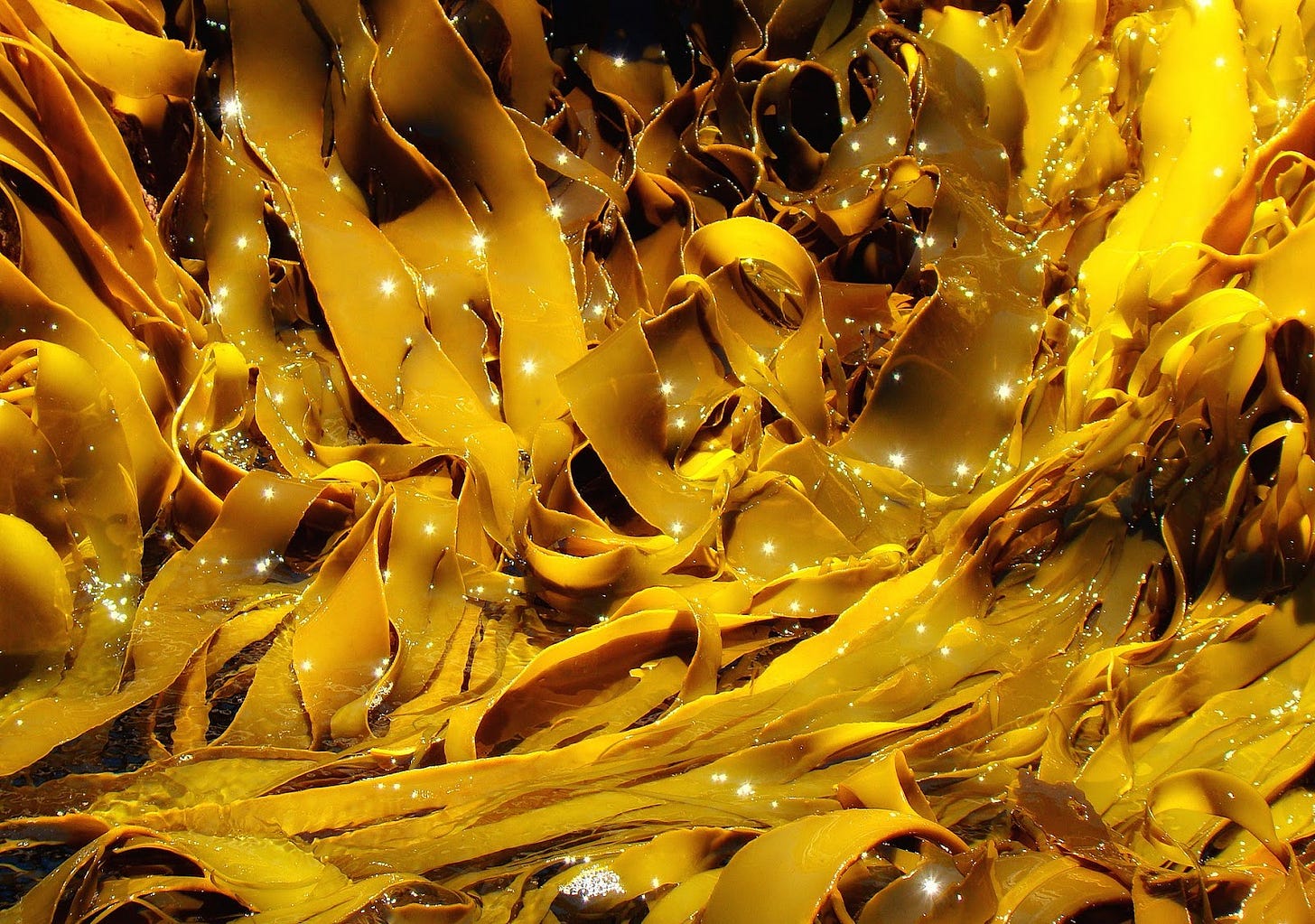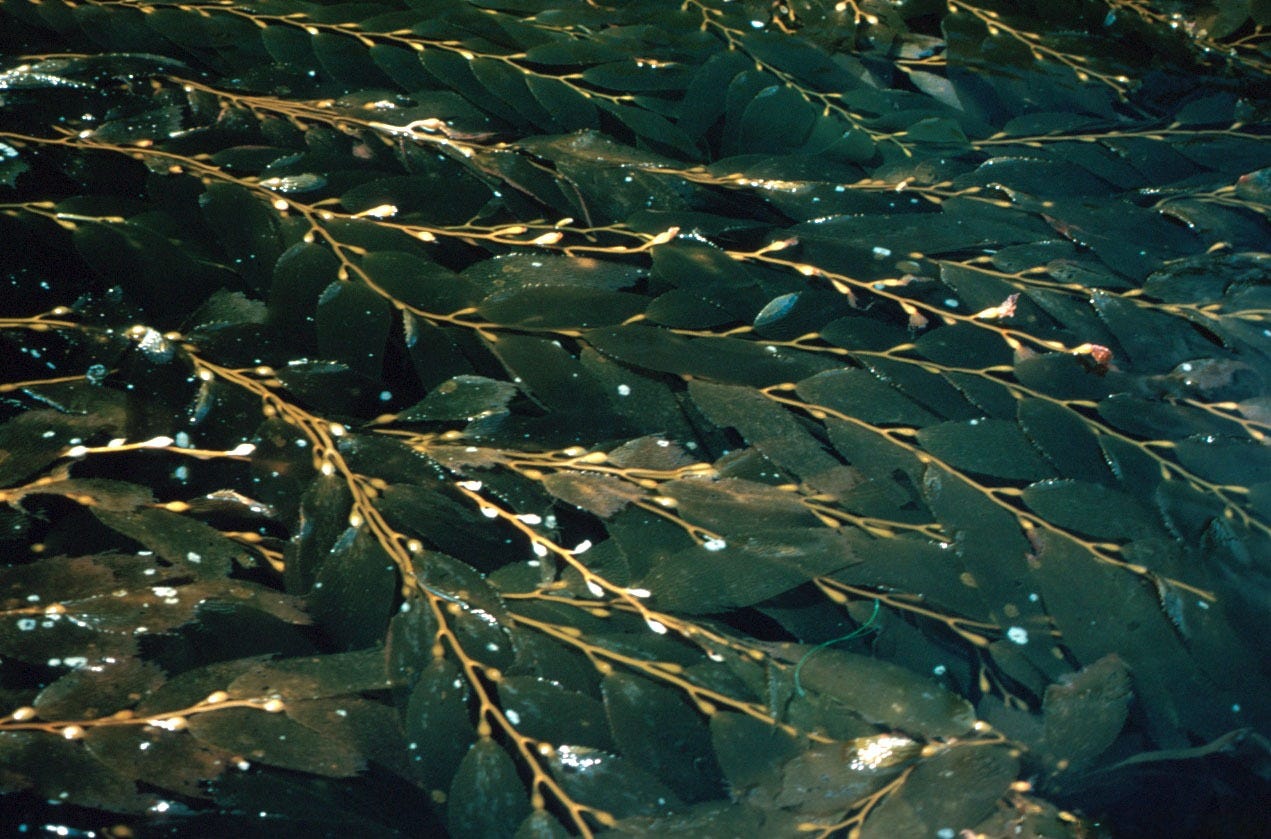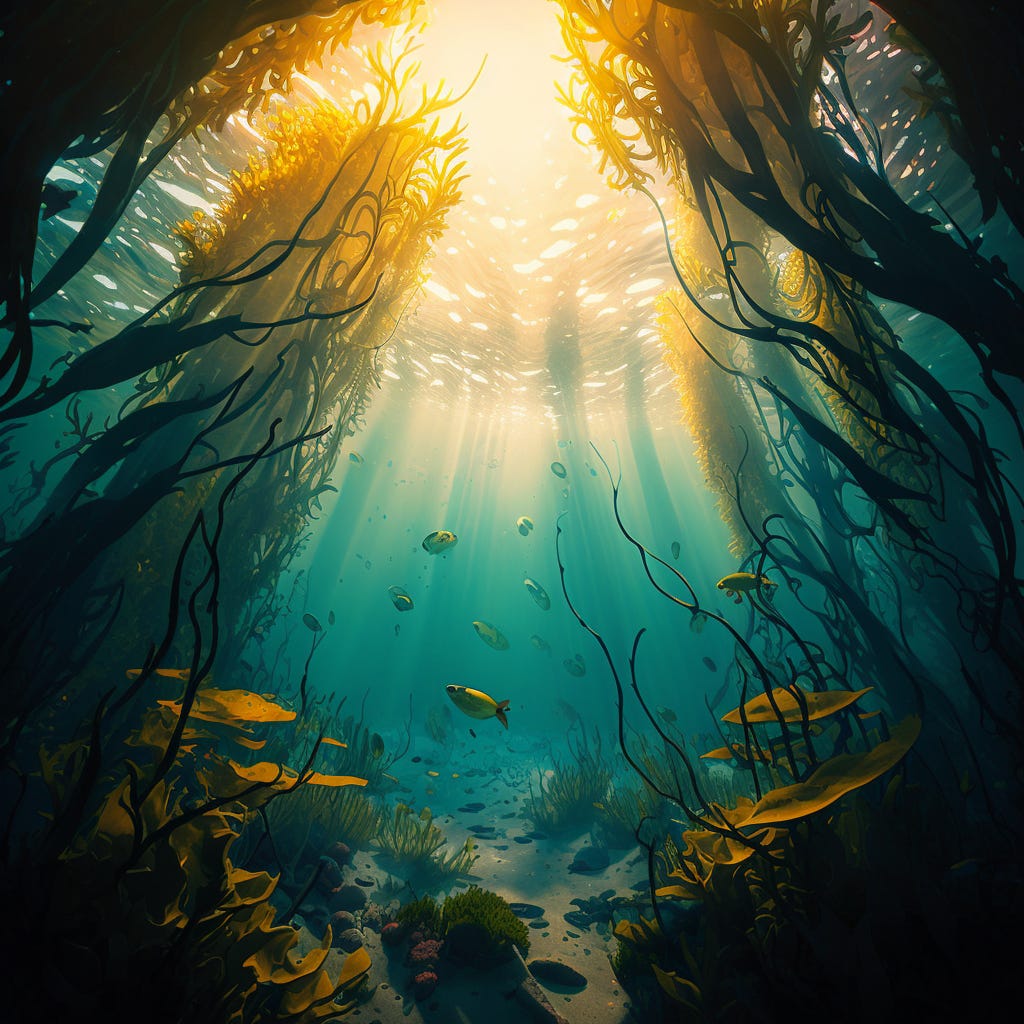Tawny brown stipes sway with the to and fro of the current, held fast like an anchor to the rocky, shallow waters. Fronds reach upwards to the ultraviolet rays that beam down to meet them. Among the tendrils prey and predators play a game of killer hide and seek. Blanketing the coastline of almost every continent around the world, kelp forests loom large.
Yet, despite their spectacular growth rates, kelp forests are depleting at an alarming rate in recent years. Their functions as a marine habitat, food source, and sequester-er of anthropogenic carbon emissions have also declined with them.

Both home and sustenance to hundreds, and possibly thousands, of species of sea life including fish, invertebrates, marine mammals, seabirds and other algae1, kelp forests are considered one of the most productive and dynamic ecosystems on Earth. While some species will spawn in the kelp forests, using them as a safe place for juvenile nursery habitats, larger predators use the long corridors between individual kelp to take their prey by surprise2. Species are split across three floors: at the sea bed; within the dense middle of the kelp stipes; and above the canopy at the surface. A literal pecking order is in place.
These powerful ecological communities form in temperate to arctic, nutrient-rich, shallow waters where the sun's rays can reach them, aiding them in their growth of up to 150 feet! Kelp aren’t plants, they don’t have roots. Instead they have pneumatocysts (gas-filled bladders) which keep them buoyant and in an upright position - ideal for soaking up some vitamin D and photosynthesising all day.
Kelp forests cover the majority of coastlines around the world and are comparable in size to that of the Amazon rainforest basin. The largest kelp forest can be found in the northeastern Pacific. It stretches from the coast of California all the way up to Alaska. It contains an untold number of other marine species within its abundance of over 20 different species of kelp. The benefits of kelp are limitless for marine ecosystems and for humans too.
As an ecosystem engineer, kelp forests massively contribute to the overall health of the ocean. Since they develop in milder waters than coral reefs and mangroves, they uniquely benefit thousands of species as a completely separate system. Meaning they offer food and shelter to marine species who could not find it elsewhere in coastal waters.
Kelp forests also offer ecosystem services, vital in fighting the effects of climate change in our oceans. Firstly, their need to photosynthesise means they are constantly absorbing sunlight and carbon dioxide from the atmosphere. Kelp grows in rocky coastal terrain which constantly erodes, so when stipes or fronds are inevitably detached from their anchorage they will drift out to the deep sea. Eventually they will sink to the ocean floor and store the carbon with them, where it will remain for hundreds or potentially thousands of years. Research estimates that kelp forests around Australia sequester 27-34% of the total annual blue carbon in the country every year. An annual 200 million tons of carbon is sequestered across the world by macroalgae such as kelp.
By drawing CO2 from the atmosphere and producing oxygen, kelp also helps to keep the conditions of the ocean less acidic, relieving the effects of ocean acidification on marine organisms who very much appreciate the effort.
Another selfless ecosystem service kelp forests offer us is their ability to slow ocean currents and protect coastal communities. Slowing the current and reducing the wave energy, kelp forests reduce the strength of storm surges and their destructive effects of coastal erosion, property damage and beach sediment removal. This protection is of great importance as climate change continues to produce more severe weather.

For all of the advantages they bring to the oceans and to ourselves when healthy and thriving, kelp forests have unfortunately seen a massive depletion across the world. In Northern California alone, 95% of kelp forests have disappeared in the last seven years.
Their main threat is overfishing. When marine mammals, fish and invertebrates are overfished, grazer populations are allowed to roam free. Without limitation from predators, sea urchins and other herbivores will devour entire kelp forests in just a month. Forests in Tasmania’s east coast have been decimated in recent years.
On top of this, the pollution produced from sewage, pesticides, industrial waste and inorganic fertilisers, all contained in freshwater runoff, diminishes kelp reproduction drastically.
Reciting a marine species threat-list wouldn’t be complete without mentioning climate change. In 2022, the latest IPCC report stated that kelp and seaweed species would continue to face massive rates of depletion as they are stationary and cannot adapt quickly enough to the high temperature extremes and shift in ocean acidification. Kelp forests can only grow in milder waters so a warming ocean is fatal. Maintaining biodiversity and with it, the finely balanced interactions between species, is the only way to stabilise ecosystems.
To fully protect kelp forests and the life they harbour, we must begin by identifying the location of the remaining healthy kelp forests. The Nature Conservancy of UCLA and UCSB, launched the world’s largest map of kelp forest canopy: kelpwatch.org. This allows us to map kelp strongholds and begin “strategic restoration”. Strategic restoration works best when governments say yes to establishing a marine protected area (MPA). MPAs are one of the most advantageous tools to defend the ocean as they address multiple issues at once including overfishing, invasive species and pollution to protect an entire local environment.
As is often the case, policy change is the best way to create real change. For example, Argentina has recently become the latest region to introduce a law that will permanently protect a huge kelp area. The Tierra del Fuego province voted to declare Peninsula Mitre a protected area and in doing so, committed to supporting the biodiversity within more than 30% of the world’s kelp forests. As this captures the most amount of carbon in the country, this is most welcome news. MPAs are established by changes in legislation such as this, which often comes from public pressure and an acknowledgement by governments of the value of the ocean they govern.
It is difficult to understate the fragility of marine ecosystems. Without a playground for biodiversity like that of a kelp forest, thousands of species go without shelter, food and protection. This leaves large swathes of the ocean and its species, vulnerable to every other anthropogenic threat coming their way.
Save kelp. Save the ocean.
Kelp isn’t actually a plant but a large brown algae.
Maybe some fish should reconsider their choice of nursery location.
Here at Beached we are building a community that can put our brains and resources together to highlight and fund solutions to the problems facing kelp and the oceans they live in. I hope you’ll join our humble community and click subscribe for free or support our work by purchasing the paid subscription.
All Beached posts are free to read but if you can we ask you to support our work through a paid subscription. These directly support the work of Beached and allow us to engage in more conversations with experts in the field of marine conservation and spend more time researching a wider breadth of topics for the newsletters. Paid subscriptions allow us to dedicate more time and effort to creating a community and provide the space for stakeholders to come together, stay abreast of each other’s work and foster improved collaboration and coordination.
One day Beached hope to donate a large percentage of the revenue from paid subscriptions to marine conservation organisations and charities to support their work too. Working together, we can reverse the degradation of our oceans.
Amie 🐋



